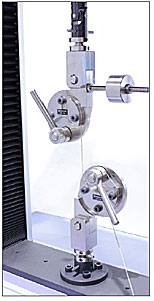5 kN Grips for Fine Wire

Features:
- Suitable for metal and textile rope, string and wire testing
- Applicable specimen diameter of 3 mm (0.12 in) or less
- Maximum capacity of 5 kN (1,100 lbf)
Relevant Materials:
Metals, Textiles
Relevant Specimens:
Ropes, Strings, Wires
These grips offer a suitable method for tensile testing soft metal wires, ropes, and strings, all with a diameter of 3 mm (0.12 in) or less. The upper and lower grips include an articulated joint to maintain alignment of the specimen with the testing axis during testing.
It is difficult to define the grip-to-grip gauge length for these 5 kN grips for fine wire. Therefore, the use of an extensometer is strongly advised.
News / Events
-
AUTOGRAGH AGS-X2 Series has been released
The Shimadzu AUTOGRAPH AGS-X2 series provides superior performance and practical testing solutions for a wide array of applications. Offering high-level control and intuitive operation, the AGS-X2 series sets a new standard for strength evaluations while providing the utmost in safety considerations in a modern, stylish design.
-
AUTOGRAGH AGS-V Series has been released
Shimadzu Corporation released the Autograph AGS-V Series precision universal testing machine. In this series, the range over which the force measurement accuracy is guaranteed has been increased by a factor of two compared with existing machines. As a result of this new function, the work required to change force measurement sensors and accessories required for measurement can be reduced.
-
High-Speed Video Camera HyperVision HPV-X3 has been released
Recording speed of 20 million frames/second, the highest in its class provides larger, clearer, high-sensitivity recording. HPV-X3 is equipped with a synchronized recording function and high-level analytical capabilities that accommodate a variety of software programs.
-
New Video: AUTOGRAPH AGX-V2 Voice Operation Device XV-Talk
We will introduce how XV-Talk, the world's first voice control device installed in Shimadzu's latest tensile tester AGX-V2, can be used in various scenarios.
-
New Video: AUTOGRAPH AGX-V2 Operation Control Panel Stand-alone test feature
We will introduce a new feature of Shimadzu's latest tensile tester, AGX-V2, a stand-alone testing function using a large color LCD touch panel.
-
New Autograph AGX-V2 Series Precision Universal Testing Machines
The World’s First Testing Machines Equipped with a Voice Operation Device


